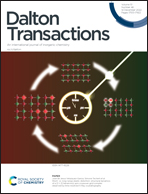Enhancing magnetic relaxation through subcomponent self-assembly from a Dy2 to Dy4 grid†
Abstract
The subcomponent self-assembly of 4,6-dihydrazinopyrimidine and o-vanillin/salicylaldehyde with different DyIII salts leads to the formation of Dy2 (1–3) and grid-like Dy4 (4) compounds with formulas of [Dy2L(DMF)4(NO3)4]·2DMF (1), [Dy2L2(CH3COO)4(CH3OH)2]·10H2O (2), [Dy2L′2(CH3COO)4(CH3OH)2]·2H2O·2CH3OH (3) and [Dy4Na2L2(μ2-OH)2(PhCOO)8(CH3OH)(H2O)]·CH3CN·2CH3OH·7H2O (4). In all cases, the DyIII ions are nine coordinate but the different features of coordinated solvent molecules and anions result in diverse coordination geometries in their respective structures. Notably, by introducing various axial coordinating anions with different electronegativities (NO3−, CH3COO− and C6H5COO−), the effective energy barriers were progressively enhanced (52–207 K) in this system. Detailed magnetic studies for these complexes revealed obvious magnetic interactions in complex 1 and clear single molecule magnet (SMM) behavior with anisotropy barriers of 52, 56 and 58.4 K for 1–3, respectively. Moreover, we find that the incorporation of benzoates into the axial position of the DyIII ions in complex 4 leads to the occurrence of two clear distinct relaxation processes, with energy barriers of 94.9 and 207.2 K, respectively. This result presents an example of the effects of axial coordinating anions on the SMM behavior, providing a valid route towards enhancing the slow magnetic relaxation of 4f based SMMs via incorporating diverse coordination anions into the subcomponent self-assembly system.



 Please wait while we load your content...
Please wait while we load your content...